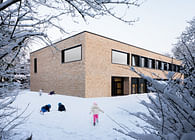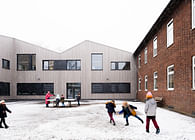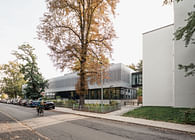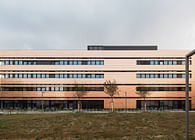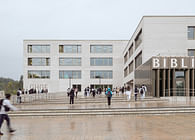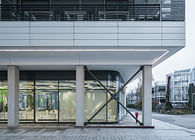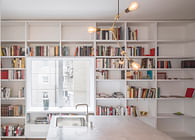
Poor but sexy is yesterday’s news.
Temporary accommodation for professional nomads designed as a building block for urban densification in growing cities. Sounds very general, but Berlin continues to attract many young people. In this case in the south-east of Berlin, in Oberschöneweide, directly adjacent to the HTW Berlin – University of Applied Sciences, an in-fill development is being built for such a use, without closing the gap site off completely. A front building allows a way through and a view of the twin building placed at the back. The result is a sequence stretching from the public street space via the accessible semi-public courtyard to the private communal garden. Using open construction, we have created living space for over 50 residents on six storeys. In order to meet the different needs of young professionals and students, various innovative residential models were developed, which either guarantee retreat in individual flats or promote communication and collaboration in small and large residential communities.
Urban planning and organisation
In terms of urban space, the building site marks the transition from a Wilhelminian perimeter development to an open row development of the post-war period. Hence, the two buildings adjoin the firewall gables of the neighbouring buildings on one side and are free-standing on the other. The different forms of housing are provided in both buildings, ensuring a lively mix of residents. In addition to individual flats, the front building accommodates a large shared flat extending over two floors, while the rear building is dominated by cluster flats for two to five residents. All flats are fully furnished and offer a high quality of life in a small space. Inclusive living areas are created through a high proportion of barrier-free flats.
Materials and colour scheme
The buildings were executed by a general contractor in solid construction using calcium silicate bricks and reinforced concrete. Dispensing with a basement and the constructive design using partially prefabricated components reduced the construction time. The smooth, light-coloured plaster façades with their generous floor-to-ceiling windows contrast with the dark, L-shaped balcony elements made of sheet steel. The elements are distributed on the façade like appliqués and are facing in different directions, offering either privacy or inviting communication.
Heat, ventilation and light
In the interests of sustainability, the building uses “low key” building services. Despite the generous window areas, it is highly insulated and features efficient external shading devices. Rooms are aired by simple window ventilation instead of a mechanical air handling system. The central heating system is supplied with ecologically generated district heating, and the rooms are heated via underfloor heating with low flow temperatures. The reinforced concrete ceilings act as storage mass for cooling in the summer months. The building is designed as a low-energy house. Smart features are available to residents in the form of a tenant app and a completely digitalised operating model, ranging from access via transponder or smartphone to monthly billing.
And what about the human being?
The pressure on available space in German cities continues to increase despite or even because of multiple crises, which is why affordable flats are becoming smaller again and the trend of the past decades is reversing. This has now led to an average of about 45 m² per resident. To ensure that the residents of our shared flats and apartments feel comfortable despite the reduced space consumption, we have integrated space-saving and smart furniture that was produced and installed by a carpentry firm. In the interior, white and shades of blue prevail for textiles and furniture, which as colour highlights help create a sense of identification. Many living areas have their own terraces or balconies, and the generous outdoor spaces between and behind the buildings add to the feel-good quality. In Berlin, life mostly takes place outside anyway.
Status: Built
Location: Berlin, DE

